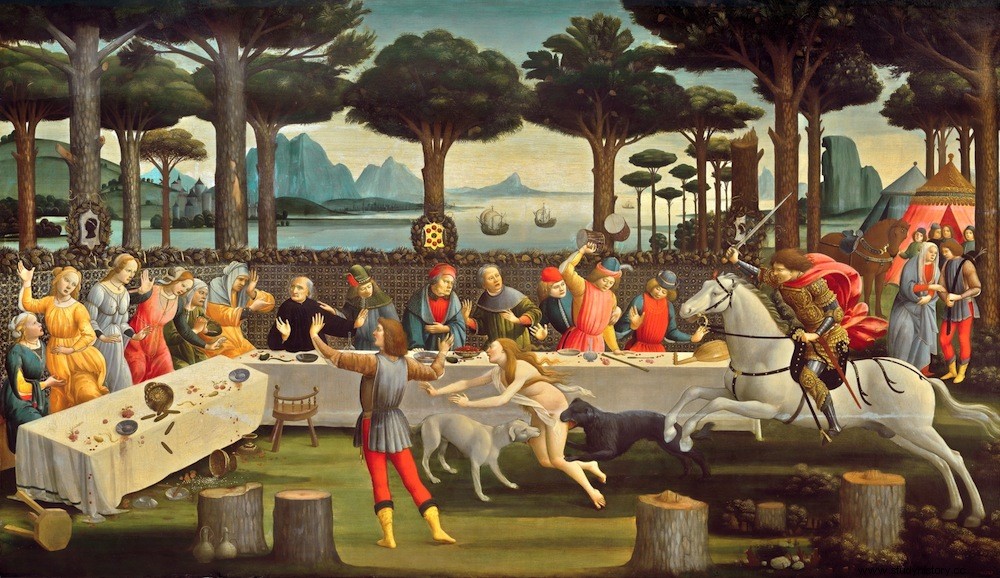We are not referring to the spirit of Don Diego Velázquez leaving Las Meninas let's see what's cooking for The forge of Vulcano; or because La Gioconda del Prado wander through the corridors trying to escape to meet your twin in the Louvre. No. The ghosts we are not referring to are in one of the corners of the room next to the Italian art gallery, more specifically in the three panels painted by Sandro Boticelli known as Nastagio degli Onesti . And it is that in them, in addition to showing a landscape (a pictorial innovation where there was any back in the fifteenth century), nothing more and nothing less than a poltergeist appears. described in the Decameron by Giovanni Boccaccio . Let's put ourselves in situation:

Table 1 Nastagio degli Onesti – Botticelli
The protagonist of the story is Nastagio , the young man in the gray doublet, red leggings and yellow boots who we see twice on the left of the first panel and who appears again in the other two. It is interesting to note that there are actually four panels:the three that we have the opportunity to see in the Prado Museum and a fourth that is in a family collection in Italy. We then see Nastagio sunk and defeated after being rejected by his beloved, daughter of a certain Paolo Traversario . He walks alone through the woods of Ravenna with the intention of taking his own life when out of nowhere he sees a horseman appear who, together with his dogs, is chasing a young and naked maiden. In a moment of gallantry, Nastagio pretends to fight against the man on horseback (that's why we see him with a branch in his hand), but then he questions him saying:
Let me fulfill divine justice!
I must relentlessly carry out the punishment that this bad woman deserves. Every Friday at the same time I reach her in this place
[Decameron, fifth day, eighth narration]

Table 2 Nastagio degli Onesti – Botticelli
Nastagio sees as Guido , which is the name of the knight, catches up with his prey and pulls out his heart with the help of his dogs. But what the young man is really witnessing is, as Guido explained, an apparition. Guido, like the protagonist, had also suffered a disappointment in love on the part of that lady and, like the other, he had tried (successfully) to take his own life in that forest. From that moment a curse fell on Guido and the maiden that forced them to chase each other until eternity, managing to unravel the young woman every Friday in that place.

Table 3 Nastagio degli Onesti – Botticelli
What we can see in the third panel is the opportunity that Nastagio found in that appearance. Nothing more and nothing less than the celebration of a banquet the following Friday with the family of his beloved. There they were able to see live and direct the persecution from beyond the grave enlivened
by the explanations of the young man who, in the middle of the scene, comments on the event with troubadour arts to the astonishment and fear of each other. If we look closely, to the right of this third panel, as a final scene, we see Nastagio talking to a young woman who is none other than Paolo Travesano's daughter. She, afraid of ending up like the ghost maiden, finally agrees to the marriage. This link appears reflected in the fourth and last panel of the work.
These canvases were part of a luxurious wedding gift received by Lucrezia Bini of the powerful family of her husband, Giacomo Pucci at the end of the fifteenth century. It is believed that it was not a simple coincidence, but a warning disguised as a work of art.
Collaboration of Marta Rodríguez Cuervo by Martonimos
Sources:Prado Museum, Decameron – Giovanni Boccaccio, The Master of the Prado – Javier Sierra.
